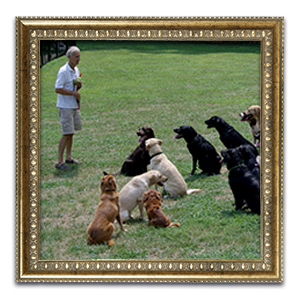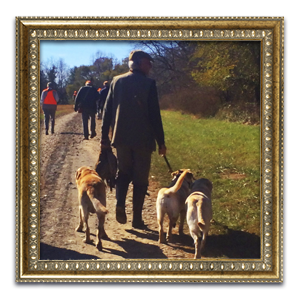
The Training of the Pack
In the late sixties a major Japanese company visited the United States and made a visit to Bill Lear, the famous creator of the Lear jet and many more inventions. At the time he was working on the first portable tape recorder that played multi track cassettes. The visitors said, “You can get seven tracks on the cassette but it is impossible to get eight.” Bill paused and replied, “It’s a darned good job that I didn’t know that as we finally did it yesterday!”
This story reminded me of when I first started training retrievers. My wife had given me a pair of lab pups, a brother and sister out of the same litter, in an attempt to give me a hobby away from the stress of running a major US Corporation in the UK.
They say that ignorance is bliss as I assumed it was as easy as buying a training book and following the instructions chapter by chapter. And that is exactly what I did; from eight weeks to ten months those pups went to school together and were taught exactly what was on those pages.
Shortly thereafter I was training on some open ground one day when a lady approached me and asked me if I belonged to a club and who had trained my dogs. She was taken aback when I explained that I wasn’t a member of any club and that I had trained the pups myself. She then informed me that she was the Secretary of the local United Retriever Club and would be delighted if I would like to attend a training session before deciding if I would like to become a member.
I vividly remember the first time I attended a URC training class as I when I approached the trainer and the other handlers and their pups I was told, “ Go and put one of those dogs in your vehicle as you do know, don’t you, that you can’t train two dogs at once, especially if they’re from the same litter.”
As I was a complete novice I bit my tongue and did as I was instructed to do. However, it became apparent within a few minutes that my dogs were far more advanced than the other young dogs in the class, and at the end of the session, by which time I had given both pups a turn, the trainer told me to move up a class.
Driving home that day I reflected on what I had been told by the trainer and what I and the pups had actually achieved. Was it beginners luck or something else that I was too inexperienced to identify?
As I became hooked on my new hobby I spent every spare moment training, hunting, and competing. The results were encouraging but I realized that I was having to spend more time than was necessary training as my dogs were primarily bench dogs and lacked the genes of the Field Trial variety. They say that if you can’t beat them, join them, and that is exactly what I did. In fact over the next six years the pair had grown to a pack sometimes numbering more that eight.
I recently read an article questioning the whole theory of the pack and whether there are alpha males that lead them. I, like many other doggy people, have both read and been told countless times that today’s domestic dogs have evolved from the wolf packs that roamed the Earth since the stone age led by alpha males. As I do not profess to be an expert on canine evolution I cannot argue with those who do. However, I can comment on my observations and experiences over the past twenty years.
I have come to the conclusion that my dogs consider me to be their leader. Why? From the age of a few weeks they have all received food, discipline, protection, and affection from me practically every day.
Secondly, both my own dogs and those boarding all live and exercise together. I always watch how the strangers and new comers are ‘checked out’ by everyone in the pack, and I’m always fascinated to see where in the hierarchy they fit within a couple of weeks. Although they might growl at one another in order to dominate, I have not had a single altercation resulting in broken skin.
Each time they are allowed out either to work, play, or eat they are called individually by name-and never in the same order. This enables me to select different dogs for different retrieves when we are hunting. For example, one may be better at retrieving from water, another may be skilled at tracking a wounded bird, and another at taking hand and whistle signals over a great distance on ‘blind’ retrieves.
Why are dogs competing in field trials and hunt tests held in waiting blinds until it is their turn to run? Because there is no doubt that dogs learn and copy from one another. The key however, is to ensure that a young dog does not pick up bad habits from another dog. How is that avoided? Everything depends upon the amount and the quality of the obedience training when the pup is weaned from its mother and has bonded with the owner and the other pack members. At this age its brain is a sponge capable of absorbing basic obedience and behavioral skills that become second nature for the rest of their lives.
If a dog is steady and does not break it is obedient, if it can’t be trusted not to, it is not. In my opinion, the biggest error of most retriever trainers is giving young dogs too many marks before the dog is obedient. They assume that if a young dog is too steady that it will not mark and lack pace. This is utter nonsense.
For the doubters, come and witness 6 dogs in a pack marking singles, doubles, and triples. They tremble with anticipation like coiled springs just waiting for their name to be called-and they love it
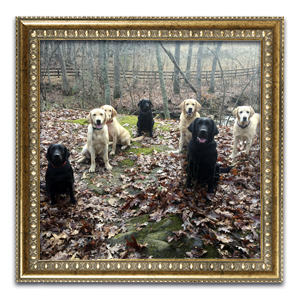
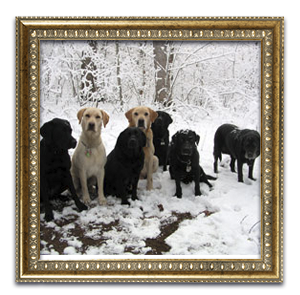
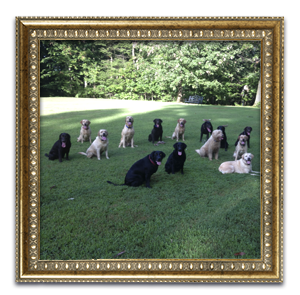

BASIC TRAINING
Socialization
The majority of dog owners do not intend to make the lives of their dogs unhappy it is just that they are unaware of the knowledge required to prevent it. What normally happens is that as soon as the dog becomes unruly the owner enrolls in the nearest puppy class. This can be a rewarding experience for both dog and owner but sometimes, if left too late, can become an ordeal.
Between the 6th and the 13th weeks of a puppies life, after it has been weaned and away from the discipline of its mother, the puppy’s brain is like a sponge and capable of absorbing huge amounts of new information. However, most families get carried away by the cuteness of their new four legged baby and wait too long before commencing the basic training.
During this period the more experiences the puppy is exposed to the better adjusted it will be for the rest of its life. The young dog needs rides in the car, visits to the town, meeting people of all ages, hearing loud and strange noises, and playing with other animals. Research has proved that dogs that are left alone for long periods when young lack confidence that manifests itself in many ways.
The worst case scenario is a young dog that has assumed the role of pack leader and is left alone too long. This is the dog that will go frantic when the owner leaves and also is likely to be destructive whilst the owner is gone. Why is this?
I heard a parent telling a friend recently that when her daughter failed to come home from the city until three in the morning she first called the police, and then the hospitals. Having established that no young girls had been abducted or admitted to the local hospital she went to her daughter’s room picked up all the clothes off the floor and in a fit of pique threw them out of the window. It reminded me of the dog that would behave in a similar fashion when its owner would leave the house just because it was worried that she would not return.
So how do we avoid making our dogs into these hard to live with animals because that is exactly what we do-the dog is not born that way. So what do we need to do?
BASIC TRAINING
Firstly, we have to assume the role of the mother so that the puppy bonds with its new owner, and secondly we have to spend a few minutes each day training the pup to sit, stay, and come. This sounds very simple and is to the experienced trainer but to an owner that has never had a dog before can be a complete mystery.
Although I grew up with dogs it was not until I was going to own my own puppy did I read books on training methods. I would read a chapter and then put what I had learned into practice and once the pup understood and obeyed my commands I would proceed to the next chapter. Consequently, when I became a breeder years later I decided that in addition to providing details of the pedigree, hips and eyes certificates of the sire and dam, that I would also provide training notes.
Young dogs and children are similar, some are bright and others are slow to learn and just because a child that struggles to keep up is not taken out of school so we must not give up on the young dog either. In fact more often than not it is the handler failing to communicate with dog rather than a stupid dog.
The only reason that owners do not always succeed is due to lack of experience and not lack of enthusiasm or responsibility. Speak to any reputable professional trainer and they will tell you that the more dogs they train the more they learn. The reason being is that just like humans each dog is different and has its own character.
Therefore, it is advisable to seek the services of a professional trainer if only to call upon their experience when behavioral problems are encountered. However, do not make the mistake of parting with your hard earned dollars by sending your young dog away to be trained on obedience if you have never trained a dog before. After all, what is the point of the dog knowing more than you?
ADVANCED TRAINING
Specialization
No matter what aspirations you have for your dog without basic obedience it will not be possible. However, as soon as both you and the dog are confident that you understand and trust one another, a whole new world opens up before you.
The pea sized brain has not grown since that wolf lived in the back of that cave, so how have modern dogs become able retrievers, seeing eye dogs, bomb and drug detectors, and can even pick up and answer the phone for physically disabled people….in a word, training.
Furthermore, an active dog is a happy dog especially if it has to work. Nowadays there are so many clubs offering a host of activities such as retrieving, agility, tracking, and much more that you are spoilt for choice. It does help of course to choose a breed that has the natural characteristics inbred to match the discipline that interests you.
For example, when I first became interested in training my first Labrador to retrieve to a standard that was required to enter competitions, both the dog and I had to spend twice as long in the training field as our competitors. As far as I was concerned a Labrador was a Labrador full stop!
Whoever said that ignorance is bliss was certainly right when it came to Digby (who came from show championship stock) and me, as we became a winning combination and reached the UK Area Finals on two occasions.
However, once I had learned my mistake my next dog came from one of the best Field Trial lines in the UK and won its first competition at 10 months old. Training Oscar was a real pleasure and so simple compared to Digby. He would sit, put his head to one side and say ‘show me’. He rarely needed showing twice and had remarkable retentive powers.
